Author Phil Warburton ◦
As amateur naturalists, we are fortunate to live in the Eurobodalla, because the South Coast is home not only to a wide variety of plant, bird, mammal, reptile, and other species, but also to several rarely observed insects.
Some of those insects have recently been ‘rediscovered’, having not been seen for many years!
There was a period in the late 19th century and early in the 20th, which was a boom period for discovering and recording Australian insect species. I can only imagine that there were a lot of people dressed in safari suits, wielding nets to catch insect specimens! These were meticulously pinned and preserved then catalogued in museum collections, by some incredibly dedicated people.
There then followed a period of several decades where many of those newly discovered species were simply not reported again. Maybe chasing insects with nets became less popular than TV or Nintendo game consoles! It is likely though, that many of those species became extinct, probably due to human development.
However, in recent years, a few of those ‘lost’ species are being re-found. We are in a new era of discovery, where hi-res digital cameras have replaced some of the capture nets and the internet has facilitated identification of obscure species.
I have been fortunate enough to have helped rediscover some of those species and establish photographic records of them. In this endeavour, I have had the generous assistance of some of Australia’s insect experts, as well as entomologists at museums and universities as far away as Oxford, Milan, Rome and New York! These specialists have helped turn photos of unidentified insects into the reference photos for species, where previously we only had pinned specimens.
The wasps
Wasps seem to be amongst our least loved insects. There is no good reason for this; most of them are solitary creatures with no malevolent intent as far as humans are concerned! They provide a vital control on the population of other insects and spiders. Without wasps, caterpillars would devour our forests and farm crops, beetles would be everywhere, and spiders might decide to finally make their putsch for world domination!
Wasps are surprisingly intelligent. It has been shown that some species remember human faces. For example, once they determine that you are not a threat to their nest, Polistes paper wasps will let you go about your business unchallenged. But when a new human face appears, they are back on their guard!
Wasps are also pollinators and one of several insect groups that have been vital for pollinating our native plants for aeons.
When species go ‘missing-in-action’, it is a concern. And lots of our wasps are currently MIA and haven’t been seen in years.
One surprisingly ‘lost’ species was the eponymous Australian Weevil Wasp, Cerceris australis. As the common name implies, it is a predator of weevils and other beetles.
There were no good photographic records for the live insect on the Australian wildlife databases – just some pinned specimens in museums dating back to early in the last century. However, a couple of individuals were recently photographed on the flowers of Parsonia straminae, the Silk Pod Vine, just north of Batemans Bay.
Finding the insect – and even getting multiple, high-quality photographs – is the easy part though. There are plenty of photos of “Weevil Wasps” on the internet – but most haven’t been identified to species. The hard part is getting a credible, corroborated ID from those photographs. If there are no reliable reference photos, you must refer to the original identification ‘keys’ in scientific papers or refer to the pinned specimen, then get the ID corroborated by relevant experts. In this case it took 12 months to go through that process!
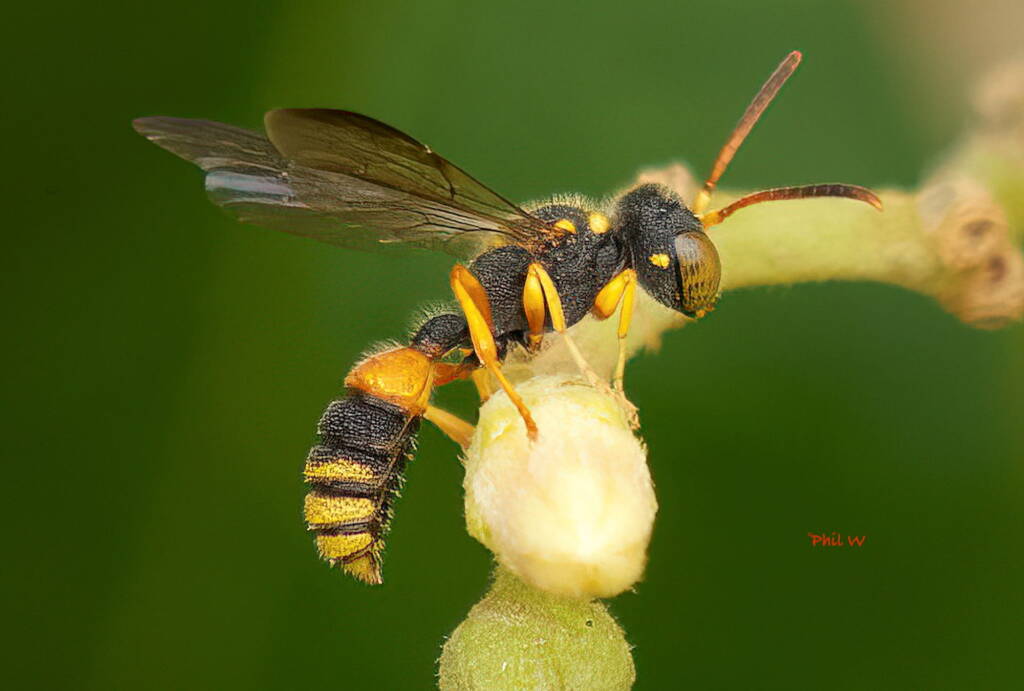
Batemans Bay NSW © Phil Warburton
Another unusual wasp was found near Dolphin Point: a splendid potter wasp, also feeding on Parsonsia straminea. No doubt many people have seen this species and mistaken it for one of the relatively common, Abispa potter wasps (believe me, it is easy to misidentify insects!).
However, the correct ID was offered by Marco Sellis, a researcher at the University of Rome, who placed it in the genus Anterhynchium. After another 12 months of exchanges with experts, digging through the old keys for the species, and reviewing pinned specimens from 1957, it was eventually identified as Anterhynchium tamarinum with the help of Marco and hymenopteran entomologist, Brian Dagley in New York.
Once again, there were no reliable reference photos for the species so this picture (below) became the reference photo for Anterhynchium tamarinum on iNaturalist and the Atlas of Living Australia (ALA).
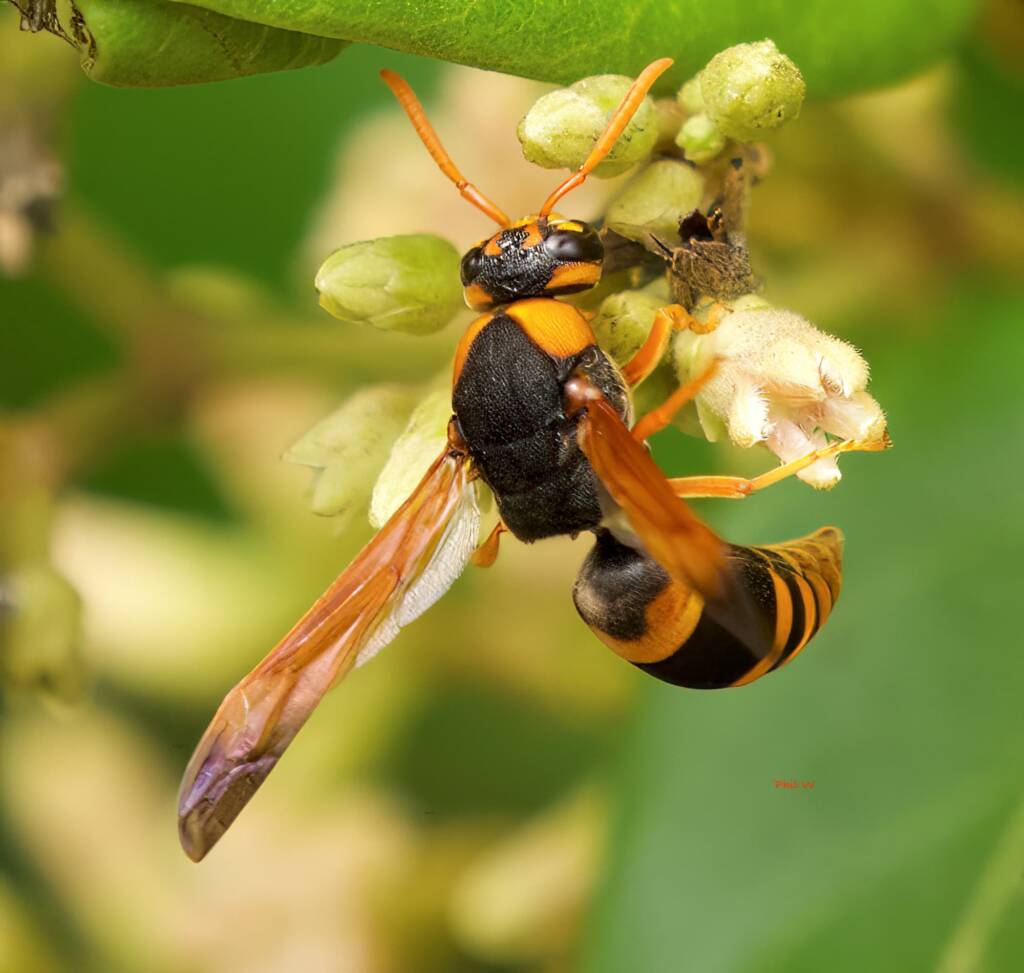
Dolphin Point NSW © Phil Warburton
Last year, I came across an unusual Thynnid Flower wasp in local bushland that had been badly burned in the fires of 2019/2020. Dr Graham Brown, who is a well known scientist and specialist in Australian wasps, identified it as Pentazeleboria janeta. This was a rare species, and one of our native pollinators, that he had referred to in his 1983 paper defining this genus. According to the ALA, there had been no accredited sightings since 1943. It is particularly pleasing to find that it survived the fires!
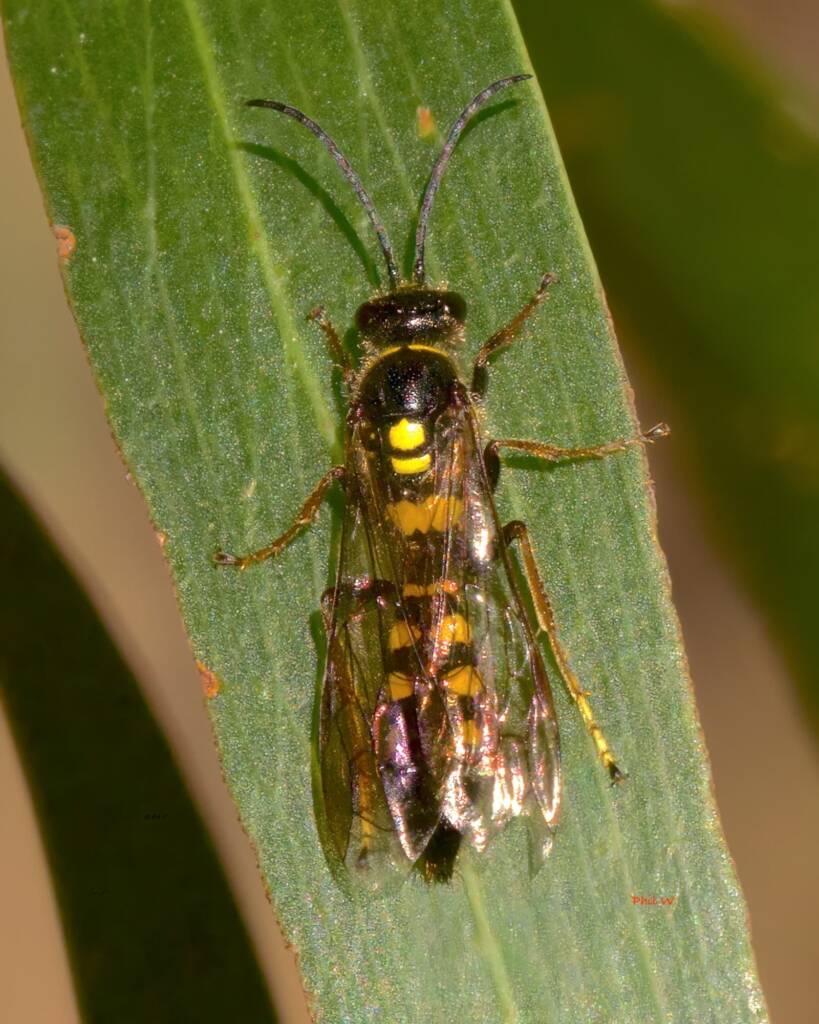
The Bees
The introduced European Honeybee gets plenty of good press for the work it does in pollinating our crops and gardens. The unsung heroes though, are the hundreds of species of native solitary bees, which have co-evolved with our native plants, and have been doing this job for millions of years. And yet some of the species that were catalogued by those early entomologists are now hard to find.
At South Durras, a couple of years ago, I photographed one of the Masked Bees in the Colletidae family. This would be easy to mistake for one of the many other Masked Bee species. However, this one turned out to be an uncommon species, Hylaeus turgicollaris. This bee was another that hadn’t previously been photographed in the wild, according to the ALA and iNaturalist databases.
Again, to firm up the ID, we had to refer to pinned specimens. Fortunately, we had the help of bee expert, Dr Michael Batley and local Eurobodalla resident and bee book author, Peter Abbott. (Peter’s book “Spotters guide to Native Bees of the ACT and South Coast” is one of the most useful in my little library). The photo shows the swollen or ‘turgid’ yellow collar that gives the bee its species name.
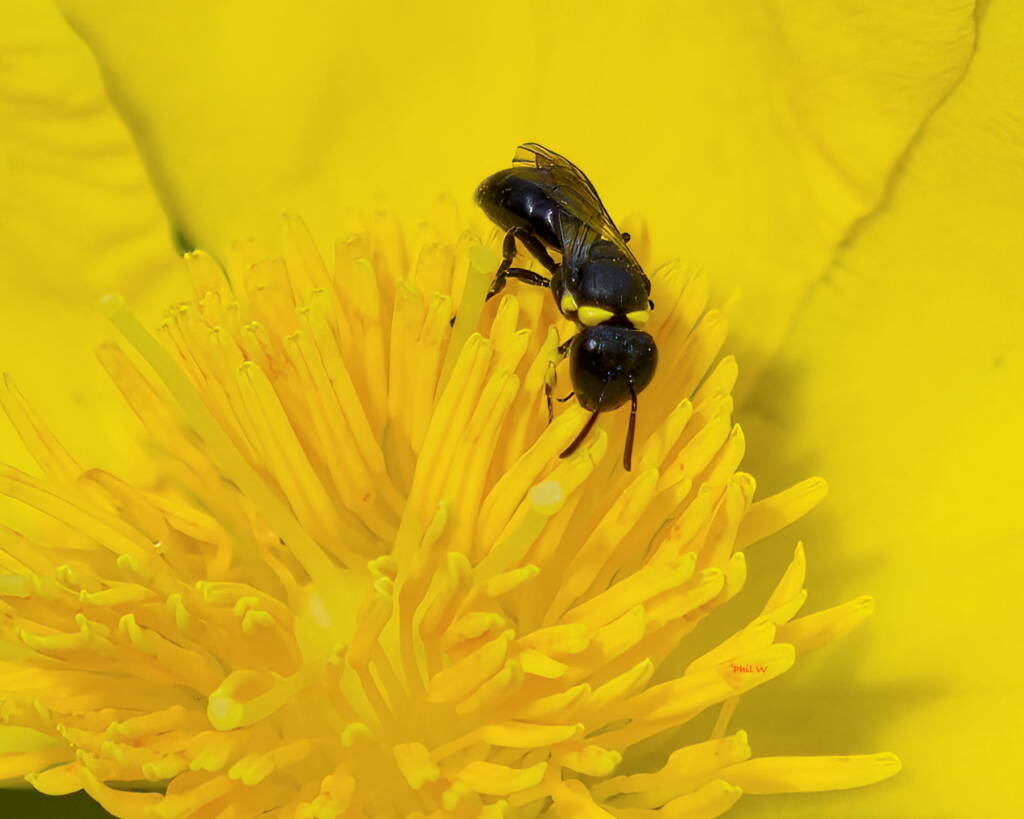
© Phil Warburton
One of my favourite places to photograph insects is the Eurobodalla Regional Botanic Gardens (ERBG). Although it too was damaged very badly by the fires of 2019/2020, the insect life is slowly returning. It was pleasing to get a photograph there of a seldom-recorded member of the Colletidae bee family, Trichocolletes orientalis. Once again, Michael Batley and Peter Abbott were instrumental in narrowing down the ID and confirming the species.
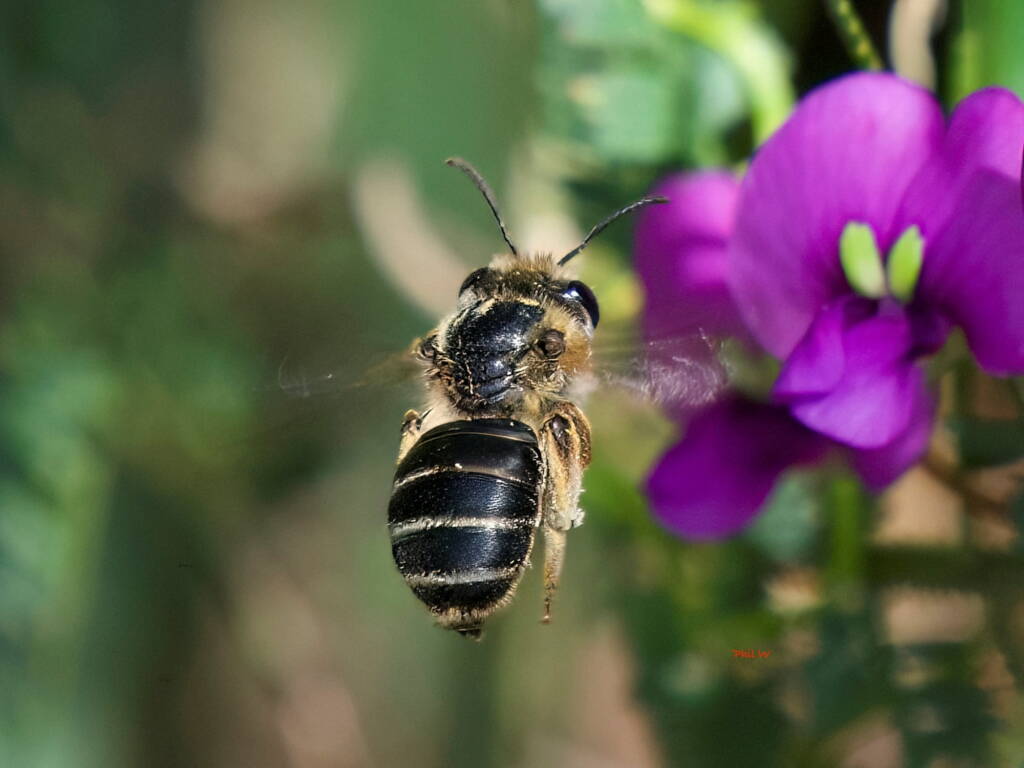
Eurobodalla Regional Botanic Gardens NSW © Phil Warburton
The Flies
Our flies are another group of insects that have an undeserved reputation. They have several very vital roles in the environment. One of those is as pollinators.
At the ERBG, a stunning member of the hoverfly family, Syphidae, was found feeding on Pomaderris discolor flowers. Odyneromyia iridescens is a bright red hoverfly with white spots that was first described in a paper in 1926.
According to the ALA, there are only six sightings of this hoverfly on their records; the most recent were pinned specimens from 1985. It is good to get the first recorded, and identified, photograph in the wild for our own ERBG!
The Pomaderris discolor is a bush that grows in the sort of marshy ground that is favoured by hoverflies. Unsurprisingly therefore, the bush was frequented by at least four other hoverfly species that were busy offering their pollinating services in exchange for nectar. No doubt this relationship between plant and hoverflies is millions of years old. At least we now know that one ‘lost’ species is still hard at work at this ancient task.
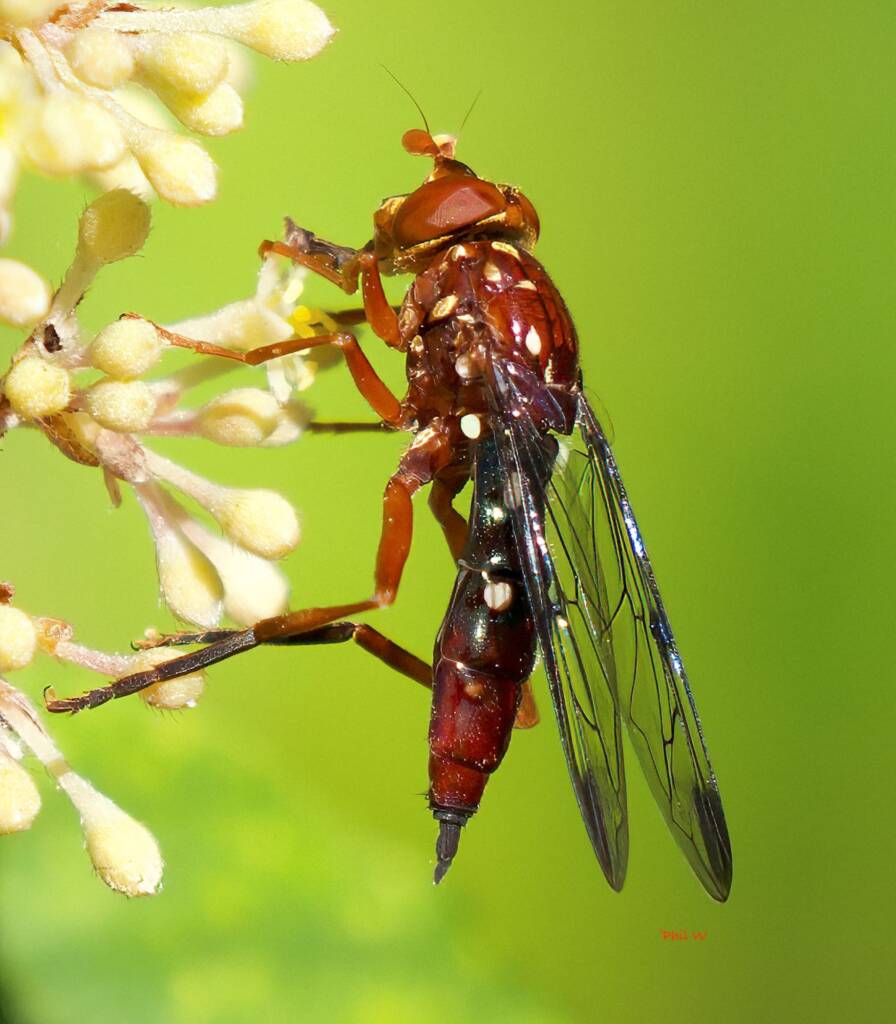
What I hoped to show, by sharing a few of these examples, is that we have a wealth of natural history in the region. Any of us could come across a species that hasn’t been well documented. It is very possible to get the first photograph, in the wild, of some of those species.
Once an accredited photographic record is established, it then becomes easier for subsequent observations to be added to the records.
The only thing to be aware of, is that getting a firm ID can be quite hard! It can take a lot of effort and the cooperation of knowledgeable people to get there. And in some cases, an ID from a photograph is simply impossible – especially if you lack multiple images from different angles. However, there are some excellent online resources now to ease the process. iNaturalist is a wonderful resource to tap into and it gets better as more people add their observations.
Check out other author/contribution from Phil Warburton…
